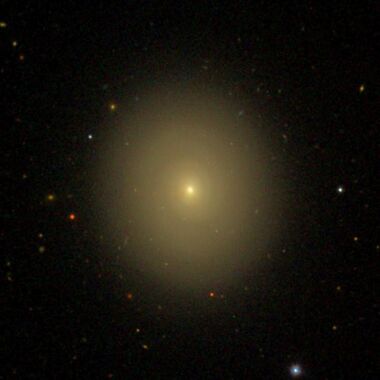Astronomy:NGC 5273
| NGC 5273 | |
|---|---|
 Sloan Digital Sky Survey image of NGC 5273 | |
| Observation data (J2000 epoch) | |
| Right ascension | 13h 42m 08.380s[1] |
| Declination | +35° 39′ 15.47″[1] |
| Redshift | 0.00362[2] |
| Distance | 54.1 ± 6.8 Mly (16.6 ± 2.1 Mpc)[3][4] |
| Apparent magnitude (V) | 11.6[5] 13.12[6] |
| Apparent magnitude (B) | 14.01[6] |
| Characteristics | |
| Type | SA0(s)[4] |
| Apparent size (V) | 2.8′ × 2.4′[5] |
| Other designations | |
| NGC 5273, UGC 8675, PGC 48521[7] | |
NGC 5273 is a lenticular galaxy located 54 million light-years[4] away in the northern constellation of Canes Venatici. This galaxy was discovered by William Herschel on May 1, 1785.[8] It is positioned 1 1⁄4° to the southeast of the star 25 Canum Venaticorum.[5]
The morphological classification of this galaxy is SA0(s),[4] indicating it is lenticular in form. It displays a faint, unbarred spiral structure within a generally elliptical profile.[9] NGC 5273 is classified as a type 1.5 Seyfert galaxy, with the X-ray emission from its active galactic nucleus undergoing significant absorption.[10] However, data collected between the year 2000 and 2022 suggest this is a changing–look Seyfert, with the type ranging from 1 to 1.8/1.9.[11] The activity level shows strong variability, allowing reverberation mapping of the supermassive black hole at the core. This object has an estimated mass of (4.7±1.6)×106 M☉.[9]
References
- ↑ 1.0 1.1 Vallenari, A. et al. (2022). "Gaia Data Release 3. Summary of the content and survey properties". Astronomy & Astrophysics. doi:10.1051/0004-6361/202243940 Gaia DR3 record for this source at VizieR.
- ↑ Pahari, Mayukh et al. (September 2017), "Detection of the high-energy cut-off from the Seyfert 1.5 galaxy NGC 5273", Monthly Notices of the Royal Astronomical Society 470 (3): 3239–3248, doi:10.1093/mnras/stx1455, Bibcode: 2017MNRAS.470.3239P.
- ↑ Tully, R. Brent et al. (August 2016), "Cosmicflows-3", The Astronomical Journal 152 (2): 21, doi:10.3847/0004-6256/152/2/50, 50, Bibcode: 2016AJ....152...50T.
- ↑ 4.0 4.1 4.2 4.3 Merrell, Katie A. et al. (May 2023), "The Mass of the Black Hole in NGC 5273 from Stellar Dynamical Modeling", The Astrophysical Journal 949 (1): 13, doi:10.3847/1538-4357/acc4bc, 13, Bibcode: 2023ApJ...949...13M.
- ↑ 5.0 5.1 5.2 O'Meara, Stephen James (2007), Herschel 400 Observing Guide, Cambridge University Press, p. 193, ISBN 9780521858939, https://books.google.com/books?id=Nyh9fAC_tpIC&pg=PA193.
- ↑ 6.0 6.1 Véron-Cetty, M.-P.; Véron, P. (2010), "A catalogue of quasars and active nuclei: 13th edition", Astronomy & Astrophysics 518 (A10): A10, doi:10.1051/0004-6361/201014188, Bibcode: 2010A&A...518A..10V.
- ↑ "NGC 5273". SIMBAD. Centre de données astronomiques de Strasbourg. http://simbad.u-strasbg.fr/simbad/sim-basic?Ident=NGC+5273.
- ↑ Seligman, Courtney, "NGC Objects: NGC 5250 - 5299", Celestial Atlas, https://cseligman.com/text/atlas/ngc52a.htm#5273, retrieved 2023-11-10.
- ↑ 9.0 9.1 Bentz, Misty C. et al. (November 2014), "The Mass of the Central Black Hole in the Nearby Seyfert Galaxy NGC 5273", The Astrophysical Journal 796 (1): 8, doi:10.1088/0004-637X/796/1/8, 8, Bibcode: 2014ApJ...796....8B.
- ↑ Trippe, M. L. et al. (December 2010), "A Multi-wavelength Study of the Nature of Type 1.8/1.9 Seyfert Galaxies", The Astrophysical Journal 725 (2): 1749–1767, doi:10.1088/0004-637X/725/2/1749, Bibcode: 2010ApJ...725.1749T.
- ↑ Neustadt, J. M. M. et al. (May 2023), "Multiple flares in the changing-look AGN NGC 5273", Monthly Notices of the Royal Astronomical Society 521 (3): 3810–3829, doi:10.1093/mnras/stad725, Bibcode: 2023MNRAS.521.3810N.
Further reading
- Vincentelli, F. M. et al. (February 2020), "X-ray reverberation lags from the 1.5 Seyfert galaxy NGC 5273", Monthly Notices of the Royal Astronomical Society 492 (1): 1135–1141, doi:10.1093/mnras/stz3511, Bibcode: 2020MNRAS.492.1135V.
- Chromey, F. R. (November 1973), "Studies of Ir II galaxies. I. NGC 4753 and NGC 5273", Astronomy and Astrophysics 29: 77–84, Bibcode: 1973A&A....29...77C.
 |

